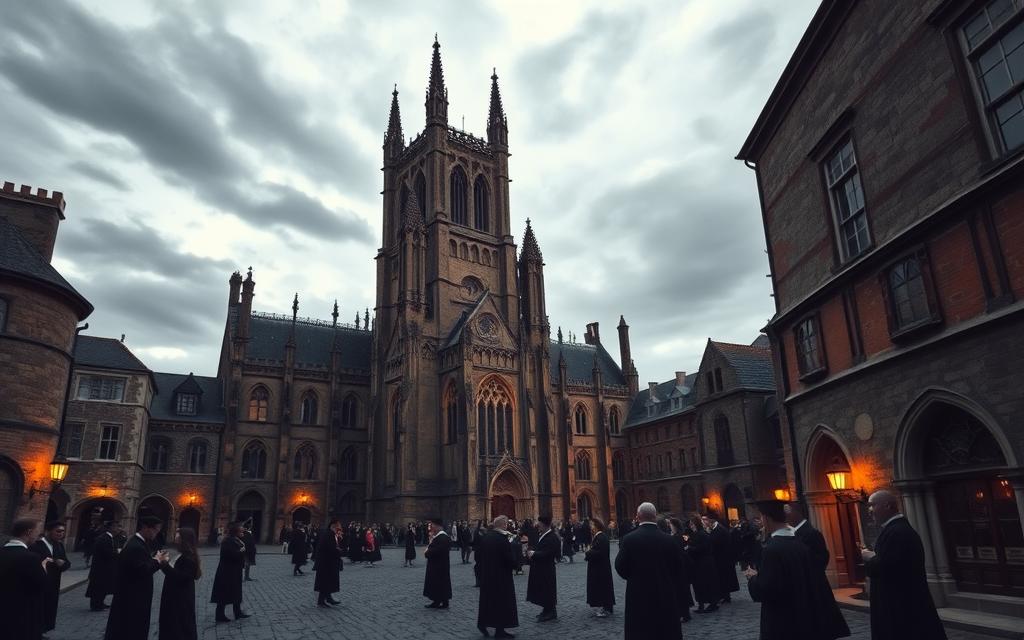The first day of school has been a significant milestone in the lives of students, teachers, and communities throughout history. As we explore the evolution of educational practices and traditions, we embark on a journey through time, from ancient civilizations to modern times.
Schooling traditions have played a crucial role in shaping the educational landscape. By examining the historical context of the first day of school, we can gain a deeper understanding of the importance of education in our lives today.
This article will take a closer look at key events, customs, and practices that have influenced educational history.
The Ancient Roots of Education: First School Days
Ancient cultures placed a high premium on education, often initiating young scholars with grand ceremonies. The history of education is replete with examples of elaborate rituals marking the first day of school, signifying the importance of knowledge and learning.
Student Initiation Ceremonies
Student initiation ceremonies were an integral part of ancient education, welcoming young scholars into the academic community. These ceremonies not only marked the beginning of a student’s educational journey but also emphasized the significance of their academic pursuits.

In ancient academies, the first day of school was characterized by elaborate school rituals, believed to invoke the gods and ensure a successful academic year. These academic traditions played a crucial role in shaping the educational practices of the time.
The study of educational practices in the past provides valuable insights into the evolution of modern educational systems. By understanding the historical context of the first day of school, we can appreciate the first day of school traditions that have been passed down through the ages.
Medieval Learning: From Cathedral Schools to Universities
Medieval learning was characterized by the growth of cathedral schools and the emergence of universities, marking a new era in education. These institutions played a crucial role in shaping the intellectual landscape of Europe during the Middle Ages.
Seasonal School Beginnings
The academic year in medieval times often began with the changing of the seasons, typically in the fall or spring. This seasonal rhythm influenced the scheduling of academic activities and ceremonies.

Matriculation ceremonies were an essential part of university life, marking a student’s formal entry into the academic community. These ceremonies were often accompanied by student traditions, such as the wearing of academic regalia and the singing of hymns, fostering a sense of belonging among students.
The legacy of medieval learning continues to influence modern educational practices, with many traditions and customs still observed today.
Colonial Classrooms: Early American School Beginnings
The colonial era in America laid the groundwork for the country’s future educational systems. Colonial classrooms reflected the societal and economic conditions of their time, with rural and urban areas developing distinct educational approaches.
Rural vs. Urban School Commencements
In rural areas, schools often began their academic year in accordance with the agricultural calendar, with students attending during the winter months when farm work was less demanding. In contrast, urban schools followed a more traditional calendar, starting the academic year in the fall.
Seasonal attendance was a significant factor in rural schools, where children’s participation in farm work fluctuated with the seasons. This led to irregular attendance patterns, with more students attending during the winter and fewer during planting and harvesting seasons.
The challenges faced by early American educators were significant, but their resourcefulness in establishing educational institutions laid the foundation for the country’s future educational success.
Back to the Books: A Glimpse into the First Day of School Throughout History
As we journey through the history of education, the impact of social class on the first day of school becomes increasingly evident. The distinction between the educational experiences of different social classes is a significant aspect of this history.
Class Distinctions in Educational Access
The class distinctions in educational access were stark, with the wealthy having far greater opportunities for education than the poor. This disparity had a profound impact on the social and economic mobility of individuals.
The industrial age brought significant changes to education, with the rise of compulsory education laws and the standardization of schools. First day traditions during this era reflected the societal values of the time, with an emphasis on discipline and hard work. The first day of school was often marked by rituals that prepared children for the rigors of industrial life.
In conclusion, the history of the first day of school is a complex and multifaceted topic, influenced by a variety of factors including social class and industrialization.
The Evolution of 20th Century School Beginnings
As the 20th century unfolded, the tradition of going back to school underwent substantial changes, reflecting broader societal shifts. The rise of suburbanization led to the development of neighborhood schools, making it easier for children to attend school.
The Rise of Back-to-School Shopping
The 20th century saw the emergence of back-to-school shopping as a significant cultural phenomenon. Parents and students alike would prepare for the new academic year by purchasing school supplies, clothing, and other essentials. This tradition became an integral part of the back-to-school experience.
The expansion of school bus routes facilitated the growth of neighborhood schools, enabling children to commute safely to and from school. This development contributed to the normalization of neighborhood schools, which became a staple of 20th-century education.
The evolution of 20th-century school beginnings was marked by these significant changes, ultimately shaping the modern educational landscape.
Global Perspectives: First Day Traditions Around the World
Globally, the first day of school is a time for new beginnings, with various cultures having their own distinct ways of welcoming students. This diversity is reflected in the unique traditions and practices observed during educational commencement ceremonies.
Asian Educational Commencement Ceremonies
In many Asian countries, the first day of school is marked with grand ceremonies. For instance, in Japan, entrance ceremonies are significant events where students don new uniforms and participate in rituals to mark their transition into a new academic year. These ceremonies often include speeches, performances, and the awarding of honors, setting a positive tone for the year ahead.
The advent of social media has significantly impacted back-to-school traditions. Students and parents now share their first-day experiences and photos online, creating a digital footprint of their educational journey. This shift has transformed the way we celebrate educational milestones, making it a more connected and global experience.
As we explore these global perspectives, we gain a deeper appreciation for the diverse cultural contexts that shape educational practices. The blend of traditional ceremonies and modern technology highlights the evolving nature of educational commencements worldwide.
Honoring Educational Heritage While Embracing Future Innovations
As we conclude our journey through the history of the first day of school, it becomes clear that our educational heritage plays a significant role in shaping the present and future of learning. By understanding the historical context of education, we can better appreciate the evolution of educational systems and the innovations that have transformed the way we learn.
The past has laid the groundwork for modern educational practices, and as we move forward, it’s essential to honor this heritage while embracing change and future innovations. This balance allows us to build upon the strengths of traditional teaching methods while integrating new technologies and approaches that enhance the learning experience.
By embracing future innovations, we can create more inclusive, effective, and engaging educational environments that cater to the diverse needs of students. As we continue to evolve and adapt to the changing needs of society, our commitment to honoring the past while embracing the future will be crucial in shaping a brighter educational landscape for generations to come.







